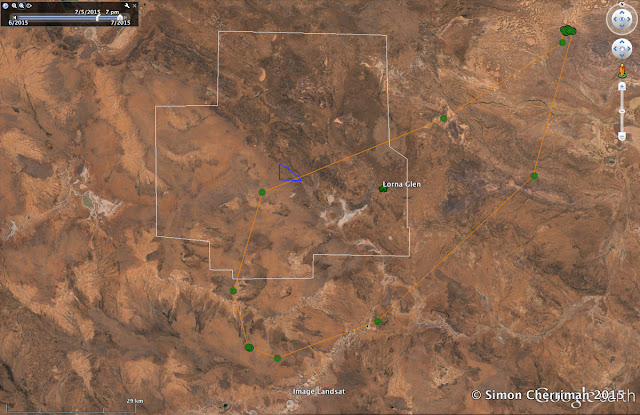It's been a very busy past couple of months in the eagle tracking world, with the 'Where Do Wedgies Dare?' crowdfunding campaign taking up much of my time... but the good news is, the time I spent marketing paid off, and the campaign was successfully funded! This means a couple more eagles are set to be tracked in the New Year! As 2015 comes to a close, I can hardly believe it's been two-and-a-half years since this project began. The data gather so far has given us incredible insights into the Wedge-tailed Eagle's ecology, and as I prepare to (officially) commence my PhD at Murdoch University in 2016, there are no doubt even more exciting discoveries awaiting us! :-D
So, what has been happening in the lives of Wallu and Kururnpa?
Ladies first! If you've been following this blog closely, you might remember that, in October, our young girl returned from a long stint at her 'second home' at Roy Hill Station and was last recorded back in the vicinity of Lake Carnegie. Information from the WA Department of Agriculture and Food's Feral Herbivore Eradication team, who have regularly flown over this area in recent months, reveals there are several sites at Carnegie with surface water present, and many other Wedge-tails of various ages were recorded at this location. This explains why Kuyurnpa is spending time here: surface water means food, and other eagles means friends (birds of a feather flock together)! Similar patterns of young, non-breeding eagles 'living together' have been observed in the Golden Eagle (Aquila chrysaetos) by my Scottish pal Ewan Weston.
The above map shows Kuyurnpa's tracking data for the months of October and November. Interestingly, she flew across the north-eastern corner of Matuwa in late October, then actually came in and roosted less than 10 km from her natal nest on Matwua on 9th December. After a brief overnight stop, she winged her way a lazy 120 km east to roost north of Lake Carnegie again. (Remember you can click these maps to view large images).
Then her interest in her birthplace seemed to strengthen. A week later, Kuyu flew over her natal territory (shown approximately by the blue triangle) around 2 pm, drifting back to Wongawol Station (the easterly neighbour of Matuwa) to roost:
 |
| Kuyurnpa's roosted on Wongawol Station on 16th December 2015. |
The next day (17th December), Kuyurnpa drifted south-west back onto Matuwa, and at 9 am was soaring at 1800 m above Lindsay Gordon Lagoon, less than 2 km south of Wallu's home range. By nightfall, after another day of floating high above the red dirt, she was roosting just 11 km south-east of her previous night's roost:
 |
| Kuyurnpa's roost on 17th December is shown by the green dot in the centre of this map (click to enlarge). |
Kuyurnpa flew south and east on 18th December, then, keen for some more time on Matuwa, she headed north-west and spent the night of 19th December in a patch of tall Gidgee (Acacia pruinocarpa) trees not far north of the Lorna Glen homestead. This roost site was in the middle of four active breeding territories on Matuwa:
On 20th December, it was time for our girl to head back to Carnegie. This map shows the latest few days of tracking data, with all roosts being either on Wongawol or Carnegie.
You can 'watch' a slideshow of consecutive days showing Kuyurnpa's travels by clicking the first map and scrolling through to see additional points from each day.
What will the next week of tracking data show? Will this trend of homeward wanderings continue?
Now... what of Wallu?
 |
| Wallu's tracking data for the past month, showing most roost sites near his nest, and the nearby rabbit warren. |
Having two large daughters to feed has no doubt kept him and mate Wurru very busy! Djentu and Minyma, which were photographed, colour-ringed and named in October, are now well and truly into their post-fledging period. I would love to have satellite-tagged them in October and be closely following their progress, but unfortunately we can only assume they are safe and well, and hope for a re-sighting of their '006' or '007' colour-rings one day in the future. Although the rain season should be approaching with the coming summer period, less than 30 mm has fallen at Matuwa in the past two months, meaning food could well be in short supply. Increasing daily temperatures, which we already know can kill juvenile eagles in the arid zone (see this post for more information), also add to the challenges these young birds face, and will no doubt claim more juvenile lives this season. Unless these birds are marked in some way, many of these deaths will go undetected, leaving us with little knowledge of the impact (positive or negative) to the Wedge-tail population.
As you can see in the above map, Wallu has remained focused around his 2015 nest site, with regular (almost daily) visits to one of the key rabbit warren hunting sites. Interestingly, though, we did record another short 'Wallu Walkabout', similar to the one recorded in January 2014, in the past five days:
On 18th and 19th December, Wallu's 9 am and midday GPS fixes showed him to be 12 and 17 km (respectively) south-east of his home-range. For an adult breeding eagle that we consider to be 'sedentary', the reasons for these forays are a mystery, but new research will always pose further questions, some of which we may never know the answer to. Perhaps more eagle tracking will help us find out!









































